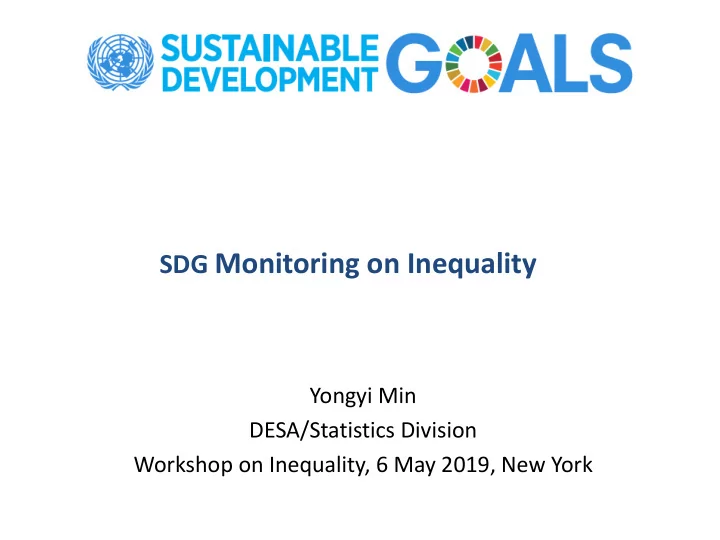

SDG Monitoring on Inequality Yongyi Min DESA/Statistics Division Workshop on Inequality, 6 May 2019, New York
Monitoring SDG 10 and the limitations SUSTAINABLE DEVELOPMENT GOALS
SDG 10. Reducing inequality within and among countries SDG 10 is a stand-alone goal on reducing inequality with 10 targets: • 4 targets : address within country inequality across social, economic and political dimensions aiming to expand prosperity, inclusion, and social protection. • 3 targets: reduce inequality among countries with attention to global financial markets, migration, and the representation and voice of developing countries in global decision making. • 3 MOI targets : directing resource flows toward countries most needed Only one quantitative target ( on shared prosperity) : Target 10.1 By 2030, progressively achieve and sustain income growth of the bottom 40 per cent of the population at a rate higher than the national average.
Global Monitoring of SDG 10 The Inter-agency and Expert Group on SDG indicators (IAEG-SDGs) was tasked to develop the global indicator framework that “… address all Goals and targets, … , and preserve the political balance, integration and ambition contained therein ”(Resolution 70/1) . A total of 11 global indicators were proposed for monitoring Goal 10 : • Income inequality: 1) growth rate of bottom 40% vs. average; 2) % of people living below median income, by sex, age, disabilities • Other includes: labour share of GDP, financial soundness indicators, migration (policy, remittance and recruitment cost), tariff applied to LDCs, and ODA, FDI and other flows
Monitoring Goal 10 – Shared prosperity • In 70 of the 91 countries for which data were available, incomes of the bottom 40 percent improved between 2010 and 2015. In addition, in 54 percent of those 91 countries, their income grew faster than the average.
Monitoring Goal 10 – Income inequality Indicator 10.2.1 Proportion of people living below 50 per cent of median income, by sex, age and persons with disabilities Correlates strongly with other inequality measures
Rationale of indicator 10.2.1 • Proposing to use same data as used for poverty measures in SDG 1.1.1 and inequality measures in SDG 10.1.1 – widely accepted and tested indicators with established standards • Data available and indicators calculated for 163 countries and 1500+ data points. • Disaggregation and aggregation limited
Other SDG Inequality Monitoring -- some examples SUSTAINABLE DEVELOPMENT GOALS
Gender Inequality F ewer than a third of senior- and middle-management positions were held by women .
Inequality by age, access to health care Births attended by skilled health personnel (%)
Inequality by geographical location Share of households per « Basic Unmet Needs » index, Colombia Colombia Zooming into Cundinamarc a Department National Administrative Department of Statistics, 2005
Providing Basic Services and Social protection systems to all to reduce poverty and inequality
Improving global SDG monitoring on Inequality SUSTAINABLE DEVELOPMENT GOALS
Improving global SDG monitoring on Inequality 2020 Comprehensive Review of the Global indicator Framework – an opportunity to improve the monitoring on SDG 10 and other targets related to inequality Improving work on data disaggregation Linking policies with data and monitoring Understanding and monitoring the intersectionality of inequality
Link vulnerable groups with their policy priorities – e.g. International Migrants Policy priorities: • Provide access to basic services (education and health care) and social protection for migrants; (Priority targets: 1.3, 3.8, 4.5 and 11.1) • Ensure fair recruitment, decent work and labour rights protection for migrants; • Eliminate all forms of discrimination and reduce violence against migrants; and • Ensure access to information for migrants.
Link vulnerable group with their policy priorities – e.g. with disabilities Policy priorities: • Poverty eradication; (Priority indicators : 1.1.1, 1.2.1, 1.3.1, 10.2.1) • Education; • Employment; • Health; • Accessibility
Thank you for your attention!
Recommend
More recommend